One of our favorite family traditions when I was young—one we shared with millions of other Americans—was gathering around the television every Sunday evening to watch Bonanza, an American Western set in Nevada near Carson City. The show chronicles the adventures of the Cartwright family, owners of one of the largest ranches in the state: the Ponderosa.
The family patriarch was the thrice-widowed Ben Cartwright (Lorne Greene), who had three sons of varying temperaments. The show, which ran a record 14 seasons on NBC, was popular because it offered both comedy and drama, and told compelling stories about the family, and those in its orbit.
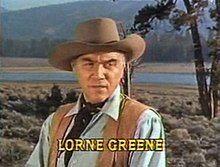
Of all the episodes I watched there is only one I remember in any detail. It was called “It’s a Small World,” and it taught me a valuable lesson.
The plot revolves around a dwarf—George—who vows to keep a promise he made to his wife on her deathbed: find a job outside the circus so their newborn daughter could have a stable life. He turns to Ben Cartwright for help who recommends him to the town banker, Mr. Flynt, because George is good with numbers, having kept the books for the circus. The prospect of filling a vacant teller slot at the bank thrills Flynt, so he agrees to interview him. But when he meets George, he recoils at the prospect of hiring a little person.
Unable to find work and needing money to feed his daughter, George breaks into the bank after hours and takes what he needs. But he is soon caught and arrested.
Cartwright promptly comes to his defense, but the sheriff tells him his hands are tied—unless he can get Flynt to drop the charges. Ben then heads directly to Flynt’s office where he implores the bank owner to drop the charges, even offering to cover the cost of any unrecovered funds, but Flynt is unmoved. Whereupon the following exchange occurs:
Cartwright: “I’m just asking for a little compassion—for a man who has just lost his wife, has a brand new baby daughter…
Flynt: “He didn’t have to steal.”
Cartwright: “He tried to get a job and he couldn’t. You ought to know that.”
Flynt: “Ah … yes … I knew we’d get around to that. It was my fault because I didn’t give him a job. Well, I didn’t force him to steal; it was in him. I tried to tell you that, Ben.”
Cartwright: “Yes, you did. You did try to tell me that and I almost forgot. He’s a thief because he’s smaller than you are—if that’s possible.”
Flynt: “Ben, I told you yesterday. He should live with his own kind! If God had meant us all to live together he would have made us all the same!!”
Cartwright [pauses, inhales, and quietly says, before walking out of Flynt’s office]: “You may be right. And I may be very wrong. And maybe you know something I don’t. You see … I don’t know how tall God is.”
That simple declarative statement—“I don’t know how tall God is”—taught me that it’s a terrible mistake—and terribly arrogant—to presume we know anything about God’s physical characteristics or who is like him and who is not. So, I have always been perplexed by the unwavering position taken by the Mormon Church regarding the complexion of Christ: he’s Aryan white. Most church members, however, would be surprised to learn that the origins of this dubious doctrine can be traced, in part, to an attempt by outsiders to paint early Latter-day saints as a racial minority.
In recent years, the church has been trying to distance itself from its racialized past by highlighting the following verse from its scriptural canon: “[The Lord] denieth none that come unto him, black and white, bond and free, male and female; and he remembereth the heathen; and all are alike unto God, …”[1] Sadly, this verse was perceived by the church in the 19th century as a potential threat, if not to its actual survival, then, at the very least, to its ability to win new converts.
During the Missouri and Nauvoo years, detractors and former Latter-day Saints began to characterize Mormons as “non-white.” They accused the church of being too inclusive, of welcoming to God’s earthly family alien individuals of all classes and colors. In the 1830s Edward Strutt Abdy, an English legal academic and abolitionist who toured America, noted that these allegations were validated by the above passage from the Book of Mormon. Simply stated, this text espoused an open racial vision too progressive for 19th century America to stomach while in the midst of a vast internal struggle over the future of slavery.[2]
Efforts to combat these perceptions soon began to influence the theology and politics of the Mormon Church. In 1849, Brigham Young instituted the Priesthood Ban, which barred all Black men from receiving the priesthood and prohibited all African American members from entering the church’s sacred temples. Then, three years later, the prophet declared himself a “firm believer in slavery” and encouraged the State legislature to pass a bill legalizing a form of involuntary servitude in Utah. Which it promptly did.[3]
Nevertheless, outsiders continued to treat Mormons as racially suspect, as illustrated by this cartoon from the April 28,1904 edition of Life magazine, which appeared with the following caption: “Mormon Elder-Berry—Out with His Six-Year-Olds, Who Take After Their Mothers.”
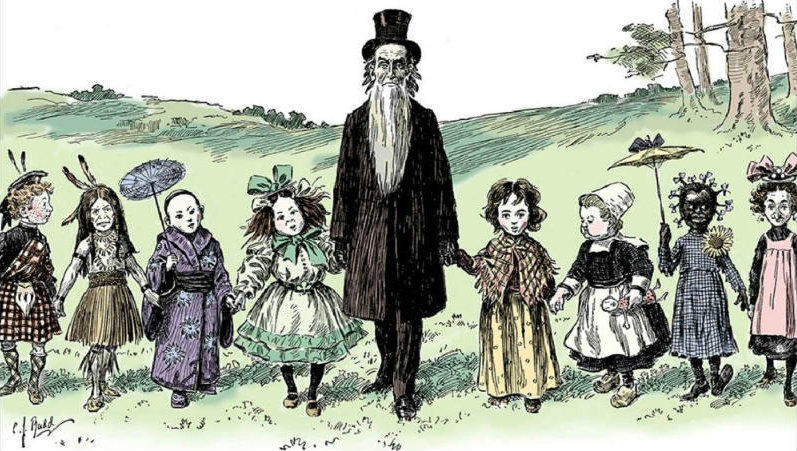
It was published while the U.S. Senate was deciding whether the first Mormon ever elected to the Senate, Reed Smoot, would be allowed to take his seat. The cartoon was not only meant to attack polygamy, which was still being practiced in the church, but also to resurrect 19th century stereotypes of Mormons as a mixed, mongrel race.
To further reinforce its “whiteness,” the church responded with images of its own: artistic portrayals of Jesus as White Anglo-Saxon Protestant. To justify its depiction of Christ as Caucasian, it reimagined God’s creation of man.
In 1868, George Reynolds, a member of the First Council of the Seventy taught that, “when God made man in his own image … he made him white. But he didn’t stop there. All of God’s “favored servants”—prophets, apostles, and, of course, his Son—were gloriously white.[4] The Bible’s failure to posit a connection between skin color and God’s favor did not concern Reynolds.
Various passages in the Book of Mormon were also cited as proof of Christ’s white complexion. Further, well into the mid-twentieth century prominent church leaders spoke of a “whitening converted Indians” which occurred when they were placed in Mormon homes.[5] But such literalistic interpretations of scripture completely miss the metaphorical meaning of these passages, where the focus is on purity, not skin color.[6] Moreover, they fail to acknowledge that Joseph Smith’s translation of the Book of Mormon was undoubtedly influenced by the world in which he lived, one where race and the spread of slavery way dominated political discourse.
In 2020, the church doubled down on its portrayal of Christ when it announced that all artwork in church foyers would be limited to 22 images featuring a white, blonde, and blue-eyed European Jesus. This decision is hard to reconcile with an ecclesiastical organization that bills itself as a “worldwide church.” And while we do not know what Christ looked like, we definitely know he wasn’t a blue-eyed European.
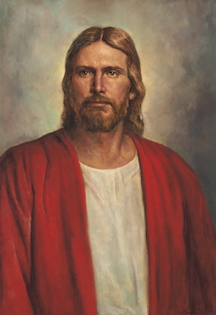
So if our belief in a “Great White God”—to use a phrase employed by Elder Mark E. Petersen and in missionary tracts in the early 1970s—reflects nothing more than a desire to create God in our image, what color is he? I don’t know and I don’t believe any mortal person does. But I have a theory, one I arrived at by blending modern and ancient scripture with science.
In his First Vision account, Joseph Smith describes seeing two personages “whose brightness and glory defy all description.”[7] Nowhere does he say they were white; rather, they simply radiated a bright and glorious light. But what color was that light? Perhaps the Israelites’ version of the ancient flood myth offers a clue.
After the waters of the deluge receded, God promised Noah and his descendants that he would never again visit such a cataclysm upon the earth and placed a rainbow in the clouds as a token of his covenant.[8]
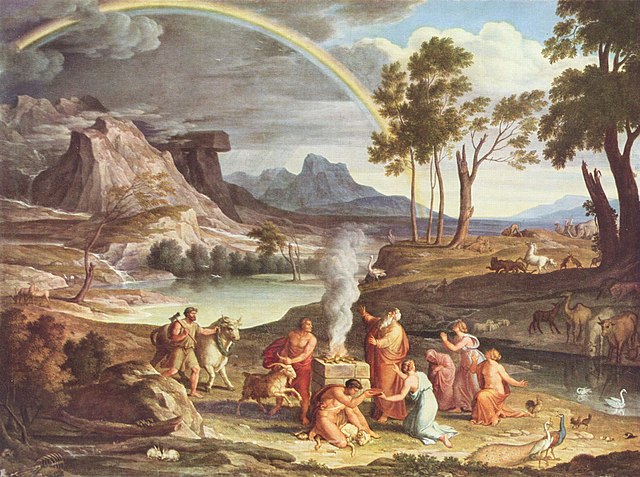
Although the Israelites did not understand that a rainbow—a spectrum of light in the sky—is caused by the refraction and dispersion of light in droplets of water, their ancient cosmology clearly positioned God in the heavens and frequently associated him with the Sun. Christ reinforced that belief when he declared that he is “the light of the world.”[9]
When we apply our knowledge of physics and optics to this metaphor, it acquires additional layers of meaning. The light emanating from the Sun contains all colors of the spectrum, including some we cannot see, such as infrared light, along with radio and ultraviolet waves. The invisible portions of the spectrum, like the Lord, are on the other side of a veil, serving as a reminder that mortal eyes have limited vision and perspective. And just as the moisture in clouds was the medium employed by God to reveal himself to Noah in all his many colors, we too must pass through water—the waters of baptism—in order to regain his presence.
The star that lights our solar system, however, is partial to one color: green. Light arrives from the Sun as photons from different portions of the spectrum, but a plurality of the photons from the Sun are from the green sector. This is a significant part of its distinct spectral signature, which is different from all other stars in the universe since no two are identical.
Green. The color of life. The color of renewal, rebirth and growth. The color of hope, of better days to come. It both calms and revitalizes, instilling a sense of peace and harmony. It is the color of the mother of our world: Nature.
The prophet Jacob employed his own Technicolor metaphor when he bestowed upon his youngest son, Joseph, a “coat of many colors.” Such a robe was a sign of royal status, authority, and favor.[10] It was given to Joseph because his father knew he was destined to be a leader of nations. He fulfilled that prophecy by rising to a position of great power in a foreign land, one where the rest of his family eventually found refuge because of Joseph’s stature in Egypt.
When people gaze at God’s rainbow, they see themselves—not alone but as part of the family of man. They are clothed, as Joseph was, in a panoply of colors and feel a connection with, and responsibility for, those around them.
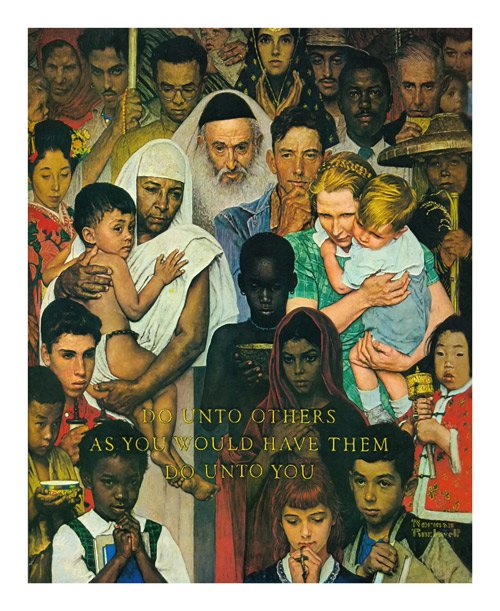
God’s light, when dispersed, gives our world it’s vibrant appearance and diverse peoples. Their differences are to be celebrated, not homogenized and correlated. “All are alike unto God” just as they are. God glories in our differences. He wishes to transform us spiritually, not physically. And when that transformation occurs all colors are integrated, becoming gloriously bright while simultaneously retaining their individuality. This, I believe, is the color of God.
[1] 2 Nephi 26:33.
[2] W. Paul Reeve, Religion of a Different Color: Race and the Struggle for Whiteness, (Oxford University Press: New York: 2015), pp. 23, 270-271.
[3] Joanna Brooks, Mormonism and White Supremacy: American Religion and the Problem of Racial Innocence, (Oxford University Press: New York: 2020), p. 30.
[4] John G. Turner, The Mormon Jesus: A Biography, (Belknap Press: Cambridge, Massachusetts: 2016) pp. 250-251.
[5] Ibid, p. 253.
[6] Douglas Campbell, “‘White’ or ‘Pure’: Five Vignettes,” 8, No. 1, Dialogue: Journal of Mormon Thought 29, no. 4 (Winter 1996): pp. 119-135.
[7] Joseph Smith—History, 1:17.
[8] Genesis 9:13.
[9] John 8:12.
[10] Zondervan Illustrated Bible Background Commentary: Old Testament: Volume 1, Gen. Ed. John H. Walton (Zondervan: Grand Rapids, Michigan: 2009) p. 121.
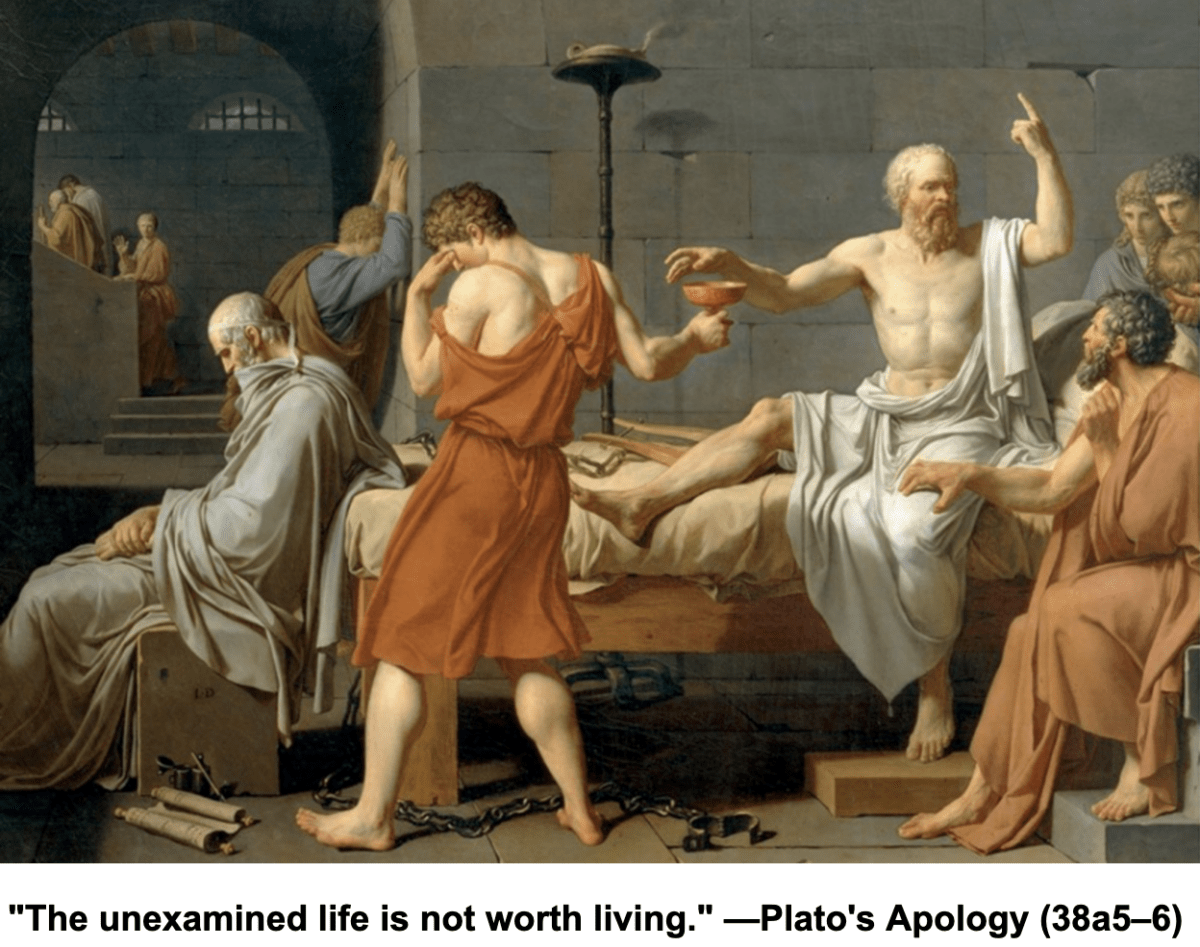
Eric, I love this post. I’m going to read it to all my kids. Plus, Shireen and I grew up 20 minutes from the Ponderosa Ranch! So this will count as a family history lesson as well!
What a beautiful theory! I’m going to reflect on this for a long time and look at light in a whole new…light. Thank you.
I really like the imagery of this article. I’d never thought of the rainbow that way. It brought to mind the imagery of Mary and child in the Basilica of the Annunciation in Nazareth. Multiple representations of Mary and Child are positioned throughout. Each was designed by an artist from many of countries that have a large Catholic population. The representations in many reflect the ethnicity of the people in those countries. To me, this multiethnic representation makes an interesting statement about the university of the gospel.
Brigham Young instituted the Priesthood Ban. Then, three years later, the prophet declared himself a “firm believer in slavery” and encouraged the State legislature to pass a bill legalizing a form of involuntary servitude in Utah. Which it promptly did.
Eric it is very interesting you should talk about this because I just did a large amount of research about this whole thing for a very balanced DUP lesson on the Indians (Native Americans) of the Utah area. I sent Margaret the info on the Old Spanish Trail and will send it to you as well. Indian Slavery was a huge problem and the Saints were being forced to purchase Indian slaves to save their lives. There were several instances in the DUP original documents where when the members of the Church were unwilling to purchase an Indian child as a slave and the Indian trying to sell the child literally bashed the child’s brains out or shot the child. This legalization of slavery seems to be more the result of the situation with Indian Slavery making legal at the request of Brigham Young, (see his statements to the legislature prior to the passage) and shortly thereafter the legislature as a follow up passed a law requiring the Indian slaves be clothed and fed. Nearly 60% of the Navajo for instance had some members of their family taken captive and sold into slavery. You might want to look into this further. Donna Oliphant currently has the DUP lesson manual with this startling info. It was really a surprise to me and is quite extensive.
Love the end and the glories of difference!
Thanks for sharing that information, Karen. As it happens, given my legal representation of Indian tribes over the past 30 years, I have had occasion to learn a fair amount about the Indian slave trade in the U.S., in general, and in Utah, in particular.
You are correct: there were several instances where members of church purchased an Indian child in order to save the child’s life. But there were many others where they were motivated by the prospect of free labor or the chance to “civilize” them.
When Brigham Young encouraged members “to buy up Lamanite children as fast they could and to educate them and teach them the gospel,” he didn’t qualify that injunction by saying “only if it’s necessary to save the child’s life.” And his words only fueled the market for child slaves.
After encroaching on their land and disrupting their way of life, he wanted to assimilate the tribes and obliterate their culture. As I noted in my essay, this mindset continued in the church well into the second half of the 20th century where church leaders spoke approvingly of the “whitening” of the skin of native children placed with white Mormon families. Trust me when I say that “assimilation” is a four-letter word in Indian Country throughout the United States.
As to Young’s attitude towards slavery generally, he believed it was ordained of God and that the descendants of Ham were destined to be the servants of others until God lifted the curse. In the midst of the Civil War, he belittled the North for engaging in a pointless Civil War since its efforts would fail to free the slaves or improve their plight. He sort of got that one wrong.
Never thought of this, but I love it, and it makes so much sense. Thanks for sharing your insights!
Aaron, I had no idea Shireen and you grew up near the Ponderosa Ranch. And to be honest, I had no idea there really is a Ponderosa Ranch! Glad you enjoyed the essay and that you can get family history credit for it as well!
Eric: You should write a book about your years representing the Indian tribes. It would be fascinating. Before I did my DUP presentation I had no idea of the scope of Indian slavery. Since black slaves in Utah were indeed rare, it is most likely Brigham Young was addressing Indian slavery as a prime concern. I always just heard “feed them don’t fight them” which is actually not the right saying anyway. The members of the Church had all their cultural superiority views and fears in relation to the (Native Americans) as well as other races but there attitudes were further complicated by the teaching of the Book of Mormon calling for teaching these remnants of Lehi’s family and bringing them to Christ. Their experiences with the Indian tribes had a rocky history fueled by misunderstanding on both sides. At times it seems the settlers just modify things to fit their oqn attitudes rather and modify their attitudes to reflect the teachings put forth in the Book of Mormon. I agree that Indian slavery was a net negative and was often the result of actually needing another pair of unpaid hands. Just that they had to pass a law about adequately feeding and clothing them is telling. Slavery with these people, however, was often not very successful as they often were rather “free spirits” and failed to acquiesce to their owners. I think the Indian slavery grew into the Indian education program. Even Brigham Young had an Indian girl who grew up in his family. I have mixed feeling about whether they did the Indians any favors by trying to make them over in a white image but I guess their experiences vary case by case. When I was young this program was just winding down. I do find the many different groups of Native Americans who we almost wiped out, and who inhabited this continent prior to European arrival to be fascinating and I mourn the loss of their civilizations.
I am glad the Church is now emphasizing that “God does not love one race more than another. His doctrine on this matter is clear. He invites all to come unto Him,” It is heartening that the Church is trying to correct what has been years of misinterpretation and prejudice.
Nichole, thank you for your kind words about my “theory.” I wasn’t sure how it would be received since it is quite speculative.
Jeff, we visited the Basilica of the Annunciation in Nazareth when we were in Israel a few years ago, but I failed to make the connection you did regarding the various artistic representations of Mary and the Child. But you’re right—they make a compelling statement about the universality of the gospel.
A mutual acquaintance of ours told me today that he had commissioned a local artist in Costa Rica to paint a depiction of Moroni as he appeared to Joseph Smith in his bedroom. And the artist did this based solely on what he had read about Moroni, without having seen him portrayed in church art. Our mutual acquaintance was both surprised and delighted with the results, which is further to your point about the value of seeing what you hold sacred through the eyes of another.
Very well said, Karen.
As to me writing a book about my representation of Indian tribes, that would be a dicey proposition since so much of what I’ve experienced and seen—especially the really interesting stuff—involves confidential matters I am not allowed to divulge. And if I did, they would probably turn around and publish certain things they know about me that I wouldn’t want others to know about. 🙂
But in all seriousness, the highlight of my legal career has been my representation of Native Americans. Being exposed to their cultures and learning their history and traditions have enriched my life and broadened my perspective in more ways than I can count.
Kimberly, I’m glad you enjoyed it and I really do appreciate people taking the time to read my ruminations. I may have one or two good qualities, but brevity is not one of them. Guess that’s why I became a lawyer.
I love this so much! First of all, Bonanza was an all time favorite in my house growing up. Great show.
Secondly, your theory about God’s true color makes so much sense! Light is all colors, not just white. I love that! I think you’re really on to something.
Have you seen Rose Datoc Dall’s recent work? She is a poplar LDS painter and is currently working on a project to reimagine how Christ may have looked. Her sketches and mock-ups are on her instagram account. They are truly wonderful.
Very enlightening. Thanks!
To be honest, S. Barnhart, I am not acquainted with Rose Datoc Dall’s work, but, at your suggestion, I took a look at some of her work and I am impressed. I like how she visually reimagines certain episodes from the scriptures. She offers a different—and fresh—perspective.
There are two LDS artists who have done some striking portrayals of the Savior that I really like. The first is Sopheap Nhem from Cambodia while the second is Emile Wilson, who lives in Sierra Leone. Here are links to two of their best known works:
https://archive.sltrib.com/article.php?id=4112042&itype=CMSID
https://history.churchofjesuschrist.org/media/christ-praying-in-gethsemane-emile-wilson?lang=eng#1